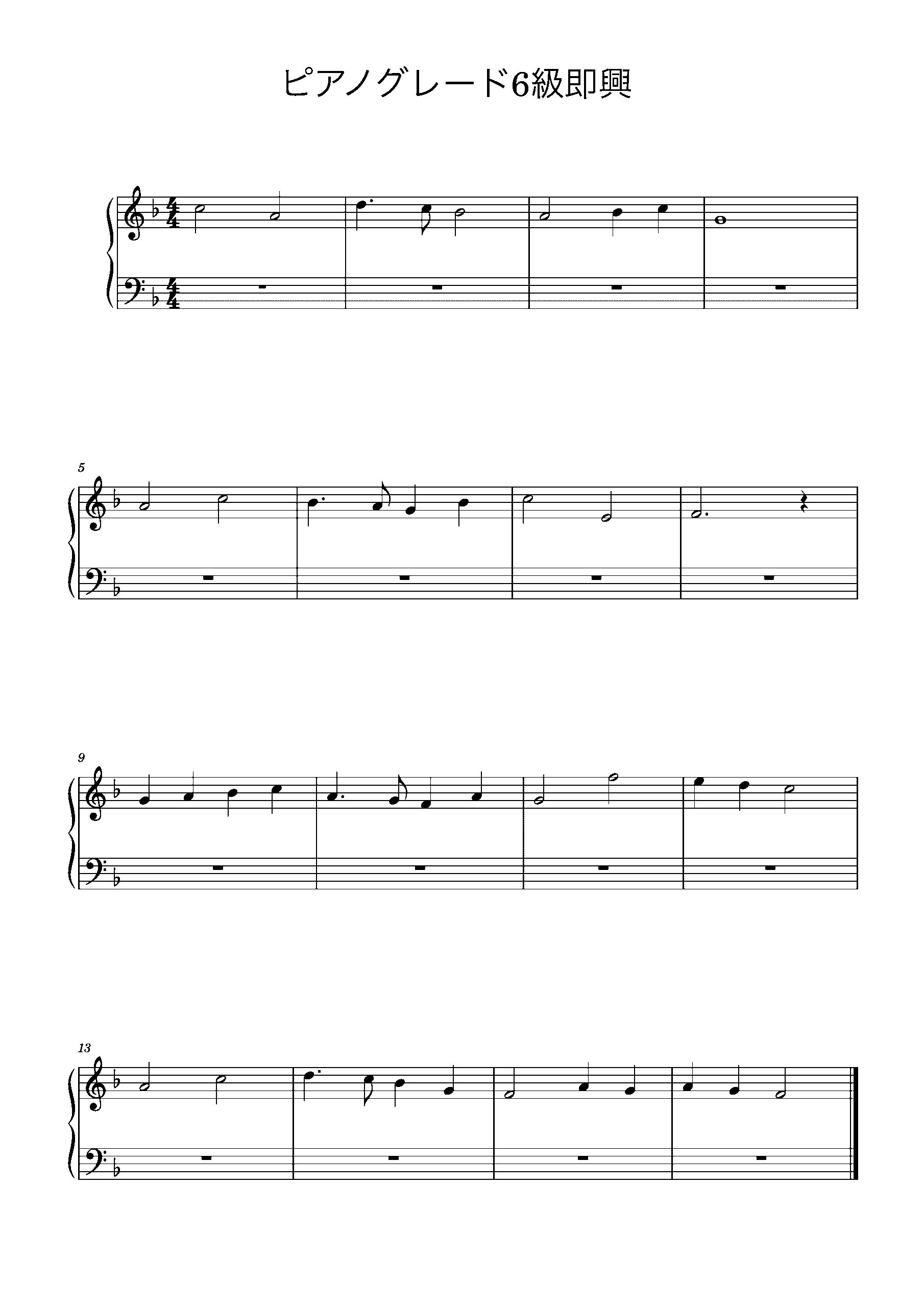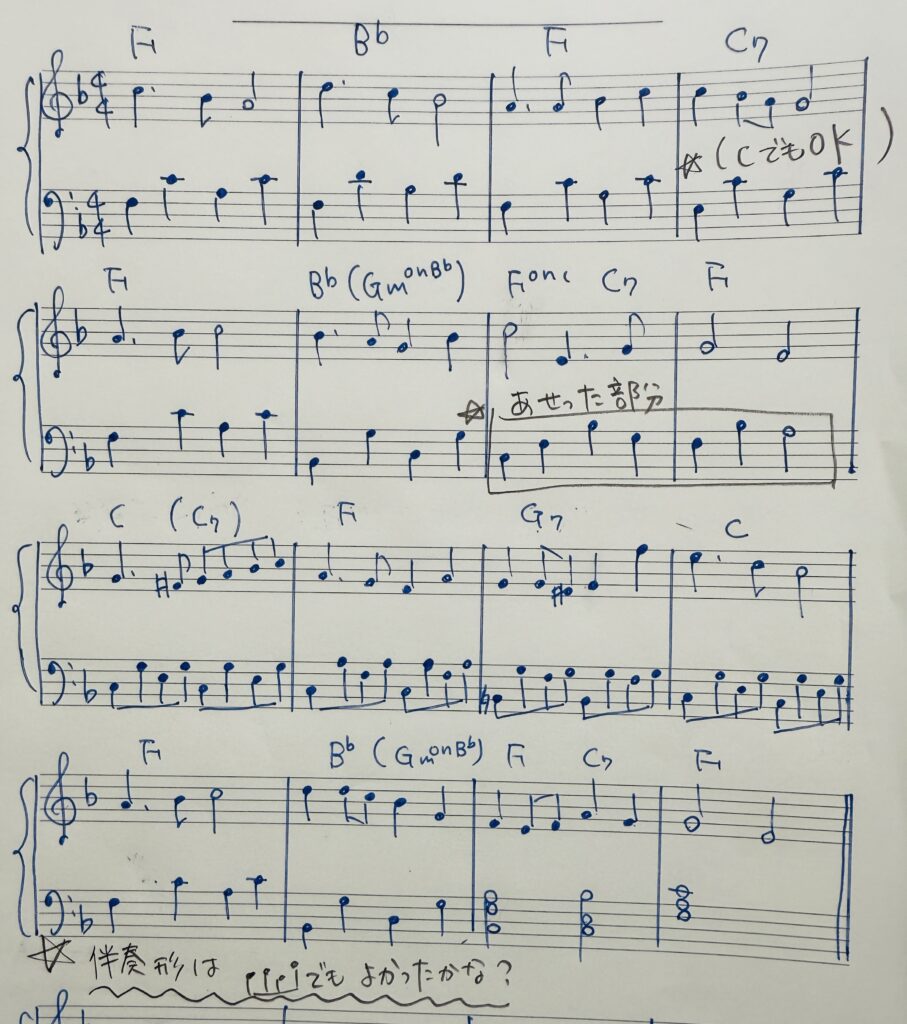ピアノグレード6級 Bコースの即興演奏(後半)
コード付けと変奏例
今日は変奏例を紹介します。
一生けんめい練習したのに伴奏付けや変奏がイマイチ。
私もとおってきた道なので、自分が一番よく知っています。ではこうなってしまう前に一体何をすればいいのかな?それも含めて自分なりに考えた勉強法をお話しします。

皆さん、コードは付きましたか?
けっこうむずかしいですよ。きちんとコード進行の勉強していないと出来ません。
特に3段目。
ドッペルドミナントの進行が入っていますね。
6級を受ける場合、これは範囲内になるのでよく練習しておいてください。
コード付け
変奏例
ズレた演奏だけど、本質はOK、見込みあり
また手書きに戻りました。
この例をもとに、演奏してみて下さい。
あせった部分は伴奏形で、
ちょっとつじつまが合わなくなった。
でもこれも即興力で、何もなかったように弾きます。

大きく表示したい方
https://drive.google.com/file/d/1gVgioyJkCJy4AOxar7w5rGmMu98WdR0D/view?usp=sharing
あぁ、どうして3拍子にしたんだろう。
変奏はとめどないい感じで、迷いながら弾いてしまっている・・・
でも演奏してしまったら止まるわけにはいきません。
しかし、この架空の演奏者はなかなか実は本質をついた変奏なんです。
その理由は、ドッペルドミナントの進行がきっちりできでいること。
ここまで、コードの勉強をしっかりとしてきたんだなという印象です。
あとは、頭の中がこんがらがってるのを、整理して練習するだけ。
4拍子なのか3拍子なのかをはっきりイメージしてから弾き始める。
即興といっても、行き当たりばったりではないんです。
そこに行き着くまでの練習は必要ですから。
- スケールとカデンツ
- ドッペルドミナントの理解
- 簡単な変奏力
- 低音の動き
あとは止まらずに演奏することです。
なんか当たり前のことだけど、とにかく基礎の基礎をやっておけということですね。
上記で演奏した、通称”空回りさん”は
テンポ感、変奏力、まずい演奏であっても乗り越える即興力が
まだまだだ足りていない状態です。
しかし、ドッペルドミナントや低音の動きが弾けているわけだから、
これまでの楽曲をきちんと練習してきた証拠。
ただ気持ちがフラフラしてて、焦った感じが演奏に出てしまうタイプ。
これから基礎力をしっかりつけていくと大丈夫です。

がんばってね
二つ目の課題はまた今度!
最近の活動
ピアノソロアルバムを作りました。すでに配信されています。
よかったら聴いてみて下さい。
公式チャンネル
English Version/Yamaha Grade 6: Assignment (Part 2)
Today, I’d like to share a variation example.
You practiced so hard, but somehow your accompaniment or variation just doesn’t sound right.
I know exactly how that feels—because I’ve been through it myself.
So what should you do before it gets to that point?
Let me share some of the study methods that worked for me.
Did you manage to add chords?
It’s actually quite difficult.
If you haven’t studied chord progressions properly, this won’t come together easily—
Especially the third line.
Yes, there’s a double dominant progression in there.
If you’re aiming for the Yamaha Grade 6 exam, this is definitely within scope.
Make sure to practice it thoroughly.
Chord Assignment + Variation Example
The performance may be off-rhythm here and there, but the core idea is solid—and promising.
I ended up writing by hand again.
Please try playing based on this example.
The part where I got flustered?
It was the accompaniment pattern.
Things didn’t quite match up.
But this is where improvisation skills come in—
Play through it as if nothing happened.
📎 If you want to view the sheet music in a larger format:
👉 View on Google Drive
Ah… why did I choose 3/4 time?
The variation feels never-ending and a bit lost in thought.
But once you start performing, you can’t just stop midway.
That said, our imaginary performer here is actually hitting the essence of variation.
Why?
Because the double dominant progression is solid.
It gives the impression that they’ve done proper chord study up to this point.
Now it’s just a matter of organizing the thoughts and putting it into consistent practice.
Before playing:
-
Decide clearly—is this 3/4 or 4/4?
-
Even for improvisation, it’s not just random playing.
-
You need practice to reach that point.
Things to study:
-
Scales and cadences
-
Understanding of the double dominant
-
Simple variation techniques
-
Bass movement
-
And above all: Don’t stop playing mid-performance
It may sound obvious, but that’s the core—solid fundamentals.
The performer here—who I’ll call Mr./Ms. Spinning in Circles—
is still lacking in tempo control, variation creativity, and improvisation stability.
But the fact that they can handle the double dominant and bass lines shows that
they’ve practiced real pieces with care.
They’re just a bit mentally scattered—and that shows in the performance.
With a more solid foundation, they’ll be totally fine.
Keep going—you’ve got this.
I’ll cover the second part of the assignment next time.
🎵 Recent Activity
I’ve released a solo piano album—it’s already out on streaming platforms.
If you’re interested, please give it a listen.




コメント